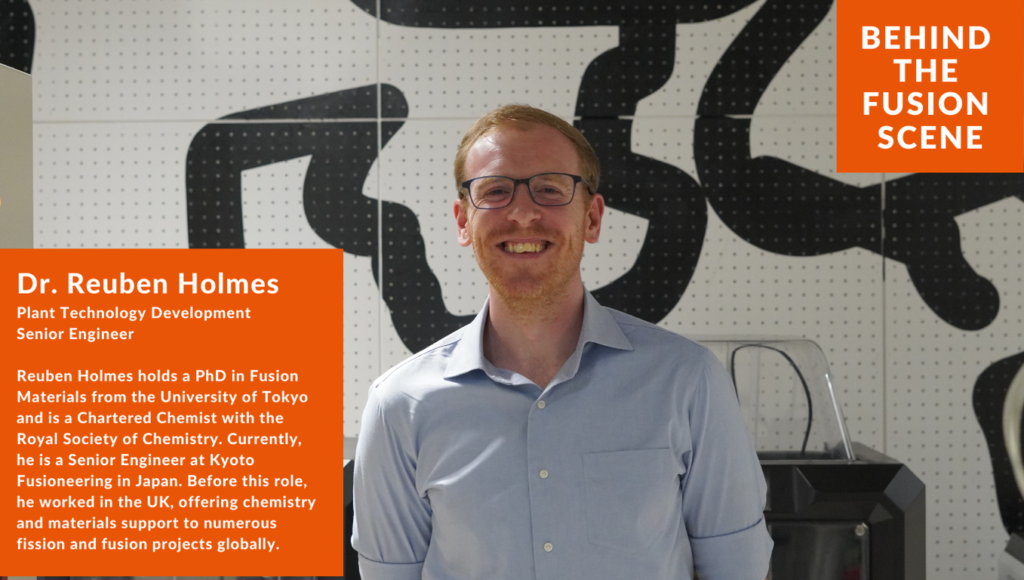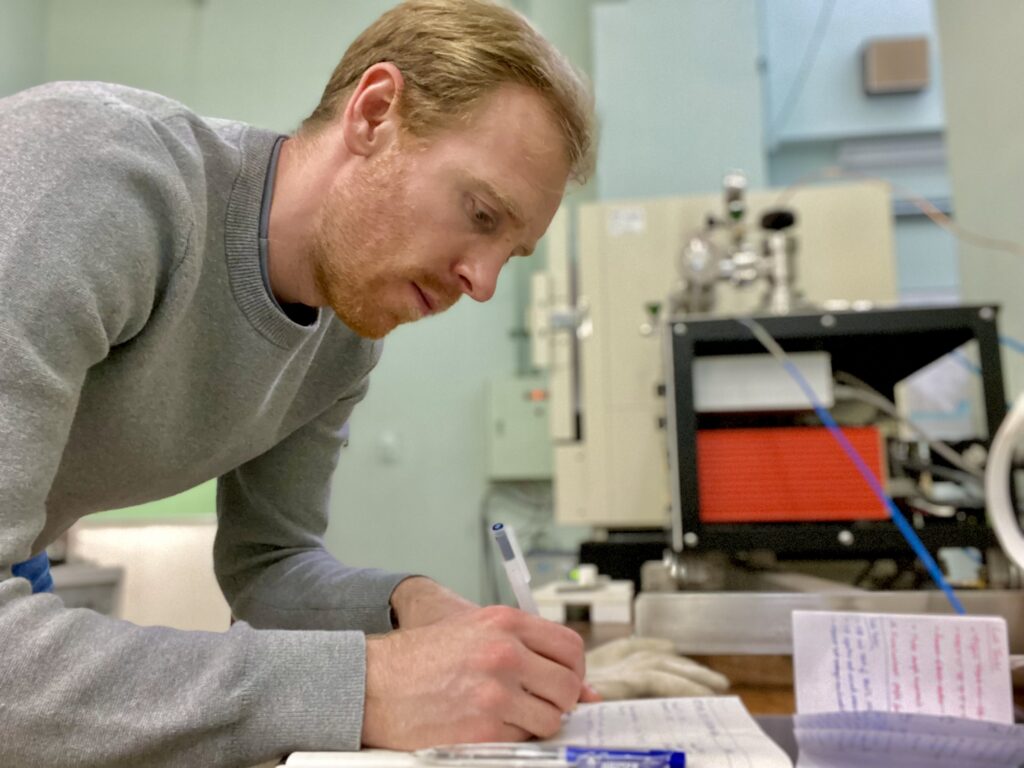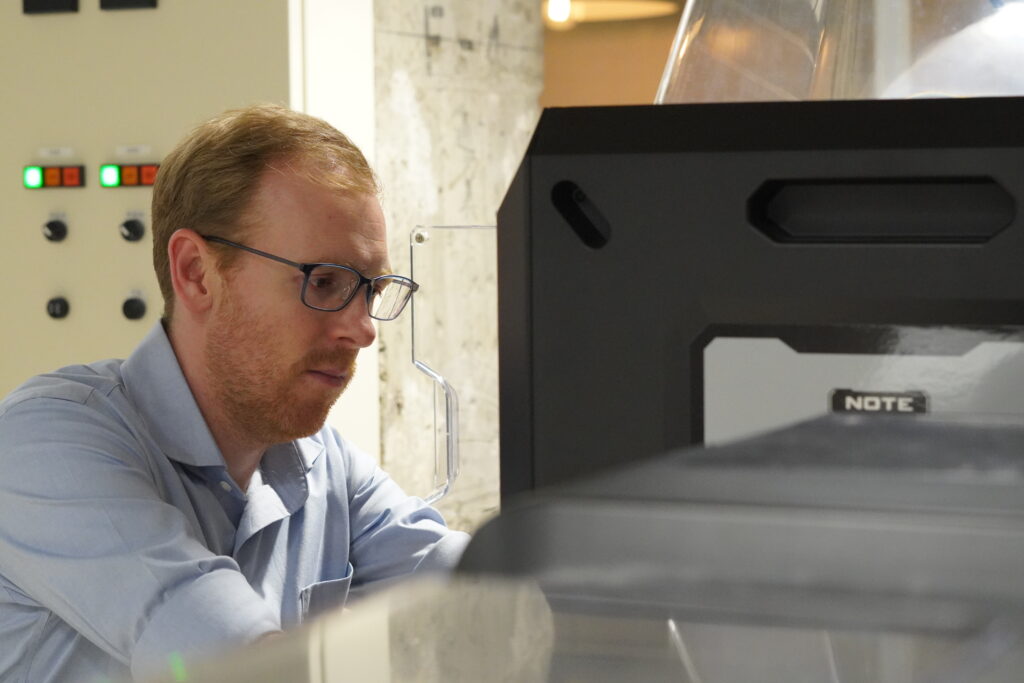
In a nutshell:
Dr. Reuben Holmes is currently a Senior Engineer at Kyoto Fusioneering in Japan. Previously, he worked in the UK nuclear sector for eight years, supporting various fission and fusion projects. His move to KF aligned with both his professional goals and personal wish to live in Japan. At KF, Holmes focuses on investigating materials degradation, by conducting literature reviews and experiments to enhance materials for high-temperature operations. His work includes studying materials manufacturing processes, their behavior under fusion-relevant conditions, and waste disposal routes. He is also exploring the use of advanced manufacturing techniques, such as additive manufacturing, to improve design, performance, and cost efficiency of fusion technologies.
What motivated you to join Kyoto Fusioneering and pursue a career in the field of fusion energy?
Kyoto Fusioneering (KF) emerged at the perfect time for me, with both the ideal opportunity and a compelling topic aligning in what felt like a stroke of luck. Personally, I had always wanted to try living in Japan, as I knew immersing myself in a unique culture would be a sure path to self-discovery and growth. On a professional level, in my 8 years working in the UK nuclear sector as a chemist I had always contemplated doing a PhD in a more engineering-focused subject to broaden my technical expertise. Furthermore, I had had many opportunities to lead small teams of technical staff, most of whom held PhDs, and after reflecting on my performance I wanted to be able to engage deeper in technical conversation, while becoming a more empathetic leader. These drivers ultimately led me to pursue my PhD in Japan, which I started in 2020. Around that time, I got connected with KF’s UK Director, Dr. Richard Pearson, and the opportunity to do an internship at KF in Japan soon emerged. After completing an internship in the final year of my PhD, it was a no-brainer to continue into a full-time role as a senior engineer!
My interest in fusion came from a project I contributed to in 2019, which looked to transfer chemistry and corrosion knowledge from fission to fusion, and I became fascinated with the challenges that fusion presented. I then reached out to a professor at the University of Tokyo whose research focused on fusion materials, and together we developed a PhD proposal that sat at the intersection of materials and chemistry. My research primarily focused on the application of corrosion protection coatings to fusion materials, and how the material-coating bonded interface evolves at both high (>840°C) and low temperatures (<840°C), essentially simulating different temperature regimes foreseeable in a fusion power plant. Finally, I developed a novel way of joining the materials at lower temperatures (~525°C), which significantly reduced materials degradation during the joining process. This work continues to be a cornerstone of my career development and is proving incredibly valuable in my role at KF.

What steps is KF taking to commercialise fusion, and how do you contribute to achieving that goal within the company?
KF is actively advancing fusion commercialisation by developing and further refining materials for practical application. In line with KF’s SCYLLA© breeder blanket concept, our focus lies in designing economically viable materials that can withstand the demanding environment of a fusion device, including high temperatures (up to ~1000°C), radiation, plasma interaction, magnetic fields, and corrosive coolants. While operating at higher temperatures typically leads to a more efficient power plant, various degradation phenomena within materials need to be managed. For example, chemical reactivity between the structural materials and coolants (liquid metals, molten salts, water, etc.) are enhanced as temperature increases, meaning corrosion becomes an issue. Magnetic fields can also contribute to corrosion of materials in liquid metal coolants such as LiPb, whereby magnetohydrodynamic effects create localised areas of high flow velocity which can add further complexity via flow-accelerated corrosion.
At KF we are building a better understanding of the various materials degradation mechanisms so we can develop materials that last longer and perform adequately in such extreme conditions, with the goal of using them to construct fusion facilities that operate economically and safely. My primary responsibility as a senior engineer lies in the investigation of materials degradation phenomena through literature search and conducting experiments and using the findings to further improve materials for high-temperature operation. This not only covers the material’s behaviour during fusion operations, but also considers the initial manufacturing process, and waste and disposal implications at the end of component lifetime. For example, I am currently reviewing how advanced manufacturing techniques, such as additive manufacturing, could be utilised to improve the design, enhance performance, and reduce the cost of the different fusion technologies that KF is developing.
What projects are you currently working on at KF?
Given my previous experience working on materials and corrosion issues in the fission sector, it was natural that I immediately became involved in similar work at KF. Still, there is a lot to learn because the types of materials and coolants are completely different, so understanding the corrosion behaviour and mechanisms between each material-coolant combination is necessary. At KF, my current focus is on the corrosion behaviour of silicon carbide fibre-reinforced composites (SiCf/SiC), particularly in liquid metals (LiPb) and molten salts (FLiBe). A key part of this role is sharing learning with the international community, and in November 2023 I was able to present a paper on this topic at the International Atomic Energy Agency (IAEA) Technical Meeting on Compatibility Between Coolants and Materials for Fusion Facilities and Advanced Fission Reactors.
Drawing directly from my PhD research on bonding of dissimilar materials, I also support the engineering design team in joining different materials. For example, KF are developing high-temperature heat exchangers made from Mo alloys, which are notoriously difficult to join to one another. My role here is to consider different options, such as introducing an interlayer material that can act as a “glue” between Mo alloys, or performing mechanical treatment of Mo alloy surfaces, both of which can act to promote joining at reasonable temperatures. The challenge does not stop at creating a suitable joint, however, as tritium and coolant compatibility of metallic interlayers or adhesives must also be addressed. Such considerations are essential for projects like UNITY-1 and UNITY-2 that face these challenges and involve cross-functional teams, meaning I get to work with engineers across KF.
To complement my materials work, I am also engaged in a collaborative project with EPRI and Vanderbilt University (VU), focused on safety design aspects for fusion facilities. We plan to adapt an existing Safety in Design (SiD) methodology developed by the EPRI-VU team and apply it to a fusion case study, with the aim of building our combined expertise of conducting fusion safety assessments. It’s a nice opportunity for me to input my materials and chemistry knowledge, as well as experience working on nuclear facilities, into developing our understanding of possible fusion facility accident scenarios and how they can be mitigated through improvements in design.

How is your experience at KF helping you grow in skills and opportunities?
After just 9 months in the job, I can already say that KF has been instrumental in expanding my skills and opening new opportunities for growth. As KF strengthens its global presence through participation in prestigious events like IAEA technical meetings and international conferences, I’ve been able to showcase our advancements and represent KF on the global stage in Austria, Japan, UK and the US, benefitting from the company’s robust support system.
Being actively involved in discussions on safety, regulations and materials at the international level has significantly boosted my confidence. This led to me building the courage to apply for a leadership role in the ASME Special Working Group for Fusion Stakeholders (SWGFS), for which I recently assumed the role of chair. In this role I hope to lead the fusion sector forwards in determining which materials require codes and standards and put in place the necessary mechanisms to build tools that will serve the fusion community. As the chair, I am encouraged to think beyond our company needs, and adopt a global perspective on the fusion sector. It’s exciting because the role allows me to provide insights and solutions for the entire sector, demonstrate KF’s commitment to the broader field of fusion energy, and practice approaching challenges with integrity.
What is your perspective for the future of fusion, and what do you want to achieve at KF?
I firmly believe that we will have commercial-scale fusion power plants in my lifetime. Still, I remain torn between optimism and realism, as I recognise the immense challenges that we must overcome to get there. KF is the perfect place to work towards this future as we are at the forefront of technology development, thanks to our exceptional academic and industrial foundations stemming from Japan and the global team we continue to build. It’s difficult to describe in words how grateful I am to benefit from the strong base created by those before me, and to now be considered as part of the team to take this knowledge forwards.
Alongside my technical pursuits, I am keen to build and nurture a positive organisational culture; one that is characterised by kindness, fairness, and integrity, and which allows every individual to be the best possible version of themself.




